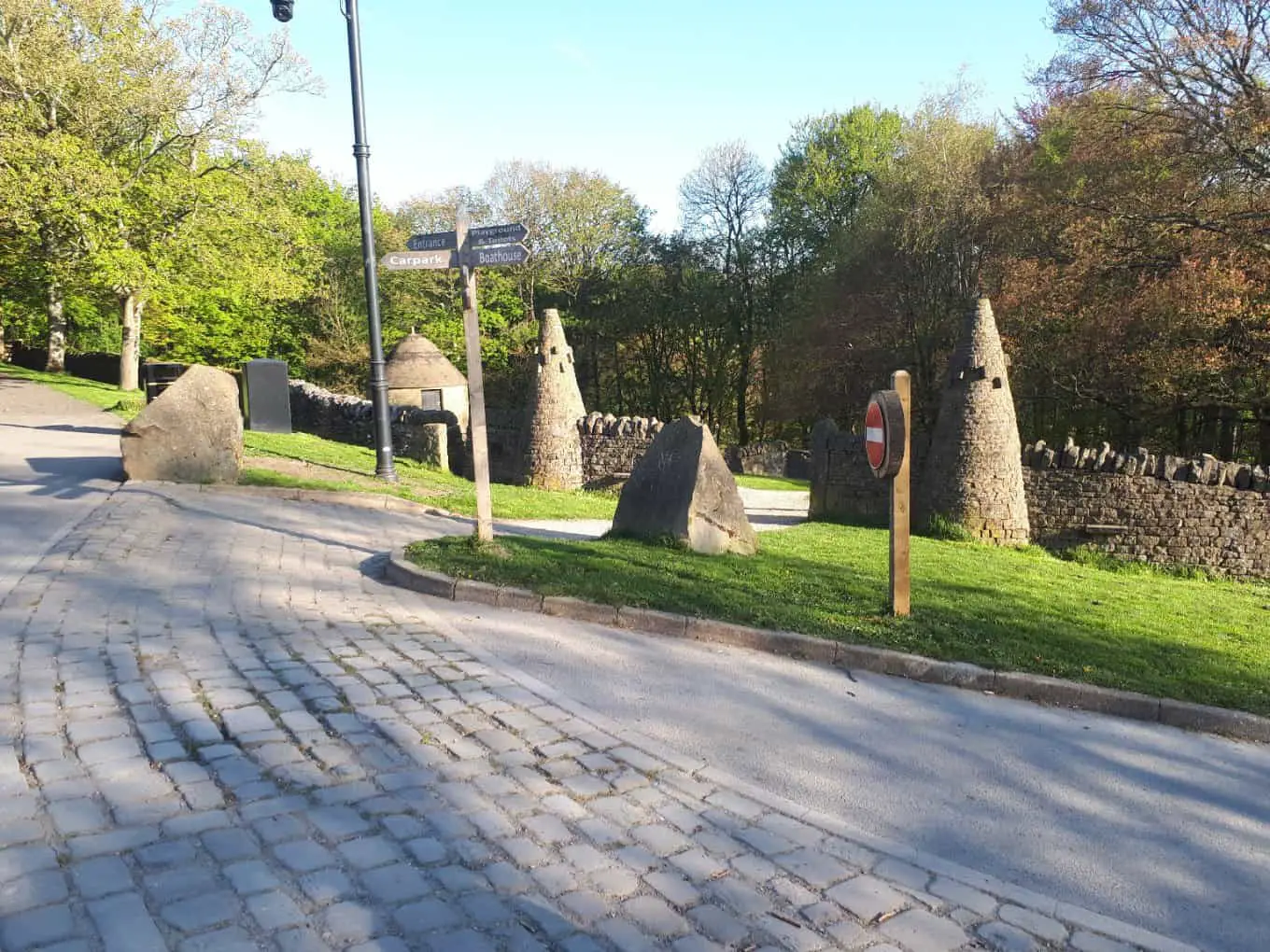How to build dry stone walls: a complete guide to Shibden Park’s exhibit and Anne Lister’s Monument representing all elements in the craft of dry stone walling shows the variety of skills of the master craftsperson, the styles and features of walling and the variety of indigenous stone found in Yorkshire.
The permanent Dry Stone Walls in Yorkshire outdoor exhibition was designed by David Griffiths and built by members of the West Yorkshire and Otley and Yorkshire Dales branches of the Dry Stone Walling Association of Great Britain, along with many others who wanted to ‘have a go’ at building dry stone walls in Yorkshire.
Supported by Johnson’s Wellfield Quarries Ltd, the Heritage Lottery Fund, Calderdale Council, ABC Meltham, Halifax PLC and the Community Foundation for Calderdale. Phase One of the Dry Stone Walls in Yorkshire exhibit was officially opened by her Grace the Duchess of Devonshire in 2003. The Mayor of Calderdale, Councillor Ann Martin, commemorated the completion of the project in 2013. The cost of the Dry Stone Walls in Yorkshire exhibit at Shibden Park was £30,300.
Contents
Dry Stone Walls in Yorkshire Exhibition at Shibden Park
The Shibden Park Dry Stone Walls in Yorkshire Exhibition is located near the Upper car Park (satnav HX3 7XA) within 32 hectares (79 acres) of informal park and woodland, which have won the Green Heritage Award.
Entrance Cairns and Gates
The design for the Twin Towers which dominate the upper entrance to Shibden Park’s Dry Stone Walls in Yorkshire exhibition is influenced by the triangular piles of stones (Cairns) marking the pathways in much of Yorkshire’s upland landscape. The pieces which protrude from the top of the cairns are ‘throughs’ that tie the top stones.
The wrought iron gate was made by Baxter, an associate member of the Worshipful Company of Blacksmiths. The ram’s head push, the crook at the hinged side and the traditional hurdle design all combine to establish the Dry Stone Walls in Yorkshire exhibit’s link with shepherding.
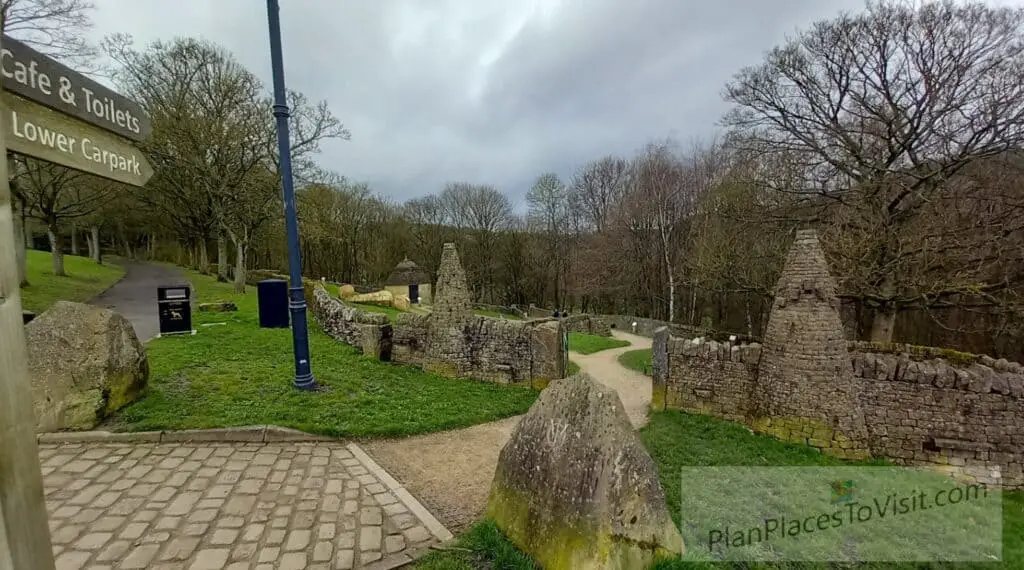
Entrance Cairns and Gates to the Dry Stone Walls in Yorkshire Exhibit at Shibden Park. The path to the left leads to Shibden’s Adney Bridge. Adney Bridge, built and named by Anne Lister, is a small bridge in Shibden Park allowing access via the carriage drive to the Gatehouse from Shibden Hall. Adney was the nickname that Anne Lister (Gentleman Jack) gave her wife, Ann Walker.
The Anne Lister Monument at Shibden
The Anne Lister Monument is a place of pilgrimage for many, as it celebrates the life of Anne Lister and incorporates traditional stone trades including dry stone walling, masonry, carving, and letter cutting.
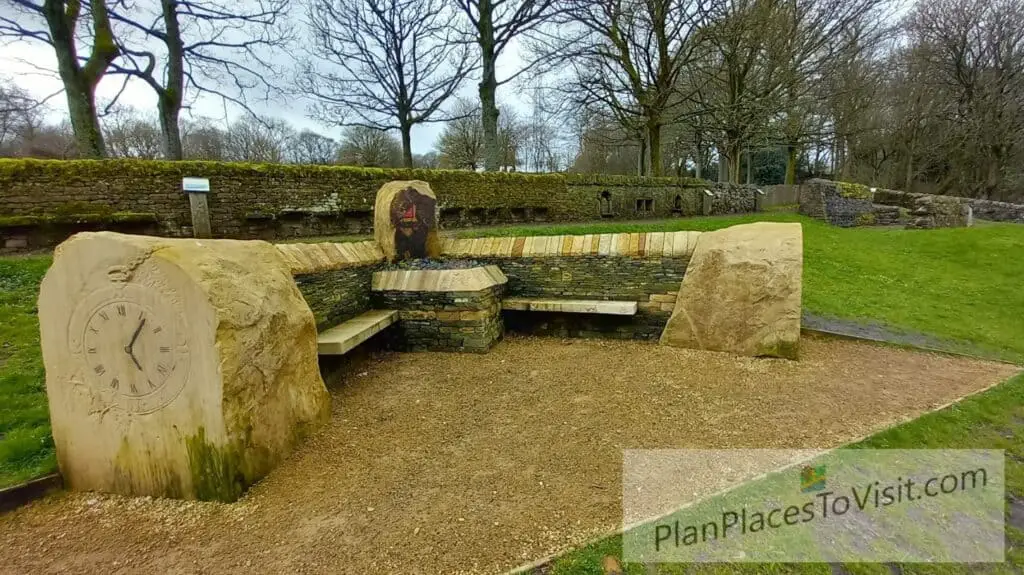
The Pocket Watch carving at one end of The Anne Lister Monument represents Anne Lister’s obsession with timekeeping while the Carriage Wheel carving at the other side of The Anne Lister Monument harkens to her love of travel. Various other carvings include coded excerpts from Anne Lister’s Diaries can be found throughout the monument.
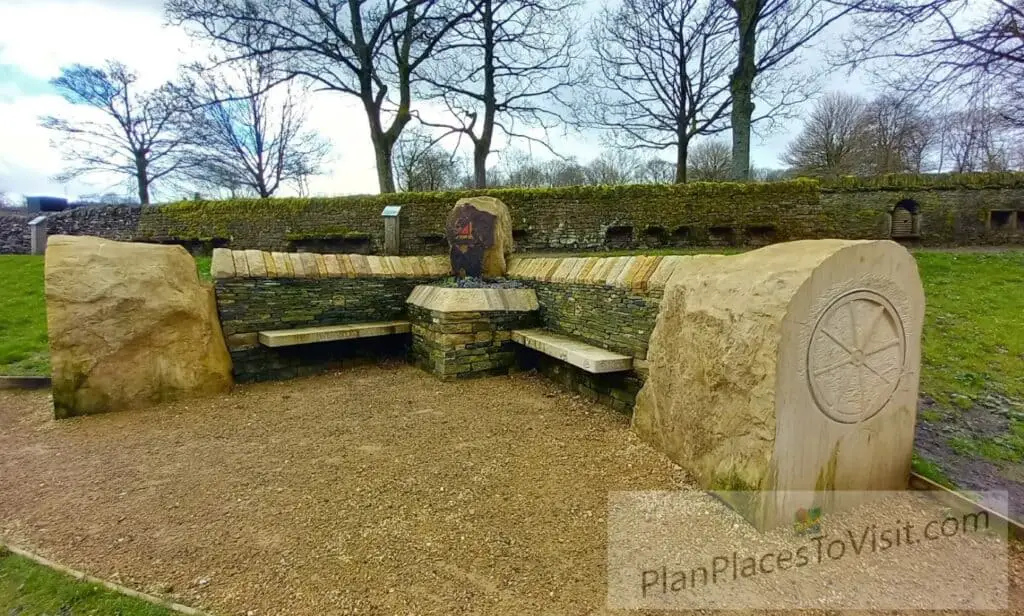
Dry stone walls of The Anne Lister Monument support the seats and planter which also house coal, a major source of wealth during Anne Lister’s management of Shibden Hall.
The Anne Lister Monument at Shibden Hall was designed by David Griffiths and built by the Women’s International Stone Alliance (WISA).
Women’s International Stone Alliance (WISA)alliance aims to promote opportunities to increase advocacy and provide recognition for women in traditional stone trades worldwide.
Behind Anne Lister’s Monument is the path that leads to Shibden’s Adney Bridge. Adney Bridge, built and named by Anne Lister, is a small bridge in Shibden Park allowing access via the carriage drive to the Gatehouse from Shibden Hall. Adney was the nickname that Anne Lister (Gentleman Jack) gave her wife, Ann Walker and more information about Adney Bridge can be found here.
The Anne Lister Monument is in the shape of a huge W for women and also M for the Mountains Anne had to climb in her life both literally and figuratively. A further site of pilgrimage for people from all over the world, adding to the growing numbers who also come to see Shibden Hall, the home Anne Lister shared with Ann Walker, to honour her life and contributions.

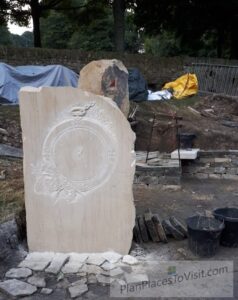
The Anne Lister at Shibden Monument also shines a light on the female stonemasons and dry stone wallers who want to encourage more women into the trade.
Emma Hudson of Traditional Stone says we need to break down barriers across many industries and people should be allowed to do what they want to do. Traditional Stone has donated the monoliths for the monuments and is sponsoring a female apprentice – Anne Lister would surely approve! Traditional Stone currently employs 5 women.
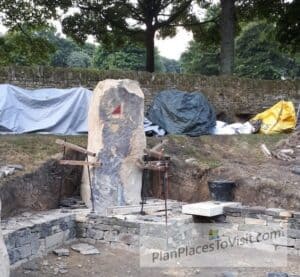
Antony Harris, also of Traditional Stone, has commented that the dimensional natural stone industry has been male-dominated for centuries, and with Gentleman Jack being a great BBC/HBO success worldwide together with England’s women football Lionesses winning the European Cup in 2022 that the timing could not be better to start the construction of the Anne Lister Monument at Shibden in Halifax.
WISA (Women’s International Stone Alliance) is an international network of women keen to work with and support other women involved or interested in traditional stone trades and has been working with dry stone walling Master Craftsman and designer David Griffiths to celebrate the strengths and capabilities of women in a culturally specific way.


Various edifices will be built around the world by skilled WISA teams, initially in England, Australia, Ireland, the USA and Italy. This will give women a rare opportunity to travel and work with other women within the traditional stone trades.
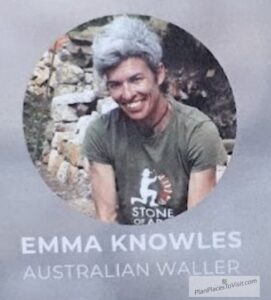
Emma Knowles will be heading the workshops. Emma originally comes from Yorkshire and is a member of the Dry Stone Walling Association (DSWA) which has its headquarters in Cumbria. Emma Knowles now lives in Australia where she runs a company called Stone of Arc. The WISA team at Shibden also included Italian stone carver Antonella Tiozzo and Italian dry stone waller Serena Cattanello
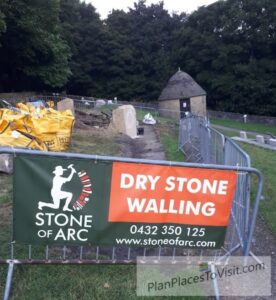
How to Build Dry Stone Walls – Methods with Explanations and Examples
How to Build a Basic Dry Stone Wall
Most of the freestanding double-skinned dry stone walls which define the British landscape and are typical of dry stone walls in Yorkshire are built using this basic method of dry stone walling comprising:
- Footing
- First Lift
- Throughs
- Second lift
- Coverband
- Copestones
Footing – dry stone walling method
The wall is firstly marked out using a batter frame or rods and ties which determine the cross-section dimensions. Note that the foot of the wall is approximately twice the width at the top below the copestone forming an ‘A’ shape. The angle produced on the side of the wall is called the ‘batter’.
All vegetation is removed such as turf or moss and the shallow trench is scraped into the earth to support the footing stones which are sometimes dug in.
They are laid into and not along the wall (trace) and form a level base for the next course to sit upon. The stones chosen are usually the biggest and roughest which are secured and filled with carefully placed ‘hartings’. A good test is to walk on them to check if there is any movement.
First Lift – dry stone walling method
Each course is built ensuring that all joints are crossed and that there are no running joints up the wall. Stones are placed into rather than along the wall, the largest at the bottom and decreasing in size as the wall lifts. A coursed wall is built with stones of the same height that follow each other along a course and a random wall is built with stones of which few are the same size.
Throughs – dry stone walling method
Throughs are large stones that extend across the wall at intervals of about one metre and tie the two sides of the wall below them together. They are left protruding at either side of field walls or can be trimmed in different ways according to practical or aesthetic requirements.
Second Lifts – dry stone walling method
Second lifts, like the first lift in a drystone wall, are tied into the course, the stones getting smaller in height with each course. The top of the wall is finished as a level as possible for the copestones to sit on.
Coverband – dry stone walling method
Where available, flat, bed slabs of stone can be laid across the top of the second lift, tying together the two sides of the wall. These are known as cover bands. They are particularly useful when the capstones are weighty but irregular in shape or short in length.
Copestones – dry stone walling method
Copestones should span the wall tying the two sides together and be tightly pulled against each other. There are at least five styles of copestone designs displayed at the Dry Stone Walls in Yorkshire exhibition at Shibden Park.
Corner – dry stone walling method
The corner of a wall is constructed in a similar way to the wall end or cheek end with occasional long pieces of stone coursed into and along the wall to add strength. Note that the batter on the corner accommodates the batter of each wall and it goes away from the corner.
Curve – dry stone walling method
There are a number of curved walls in Shibden Park’s Dry Stone Walls in Yorkshire exhibition. The most complicated in terms of technical construction is this wall which stretches from the rectangular Lunkey to the entrance cairns
Curving around and across the roots of the tree in the photograph, the wall follows a fairly level contour. Notice that throughs in this section have been left visible adopting a more traditional field wall construction. A lintel has been used to bridge a lateral root of the tree but this is only visible from the outside of the wall.
As the dry stone wall turns towards the entrance, echoing the circular sheepfold, you climb steeply and the building technique changes accordingly, the stones being laid horizontally and stepped into the slope.
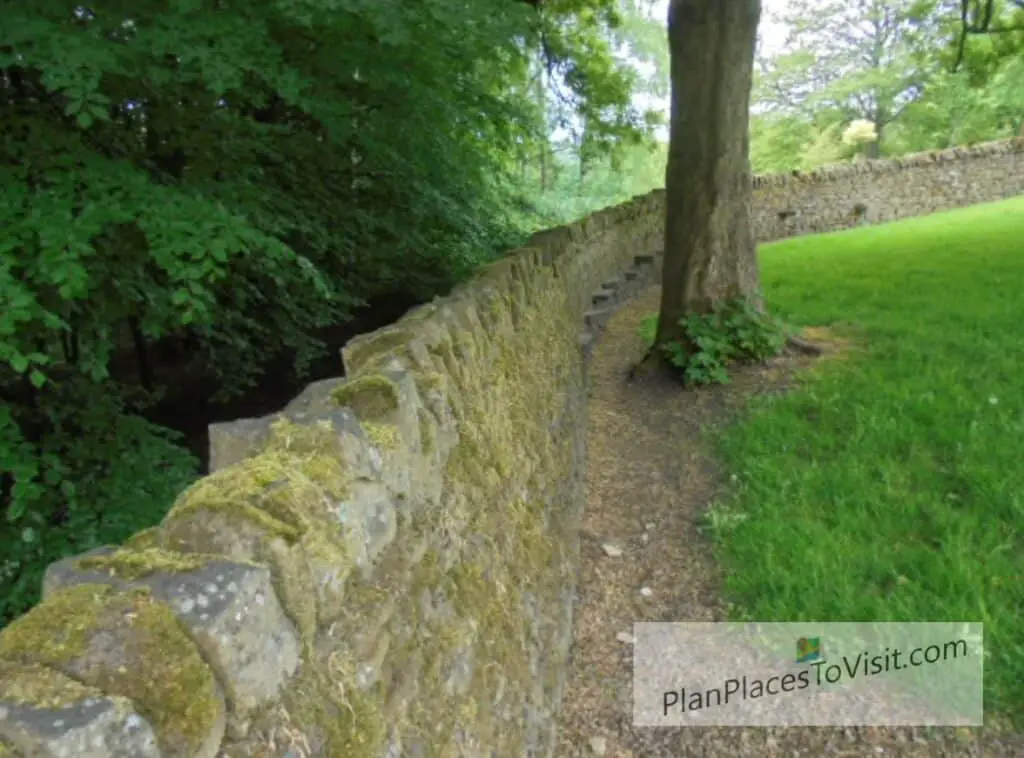
Copestone Styles – dry stone walling method
All copestones tie across and secure the upper courses of a wall. Designs vary according to the type of stone available and the traditions which prevail in different landscapes. Styles represented in this Yorkshire exhibit include:
Dressed Semi-circular or Triangular copestones – are found mainly on estate or decorative walls like the one represented at the lower entrance. These have been individually shaped using masonry chisels.
Buck and Doe is mainly a decorative copestone dry stone walling style using flat stones laid alternatively horizontally and vertically.
Sloping / tilted copestone dry stone walling style is often used when the local stone is thin and flat bedded. Each stone is laid against the other at an angle.
Traditional Yorkshire Upright in this wall the copestones have either been cut roughly in a regular, semicircular design or using stones of random height and thickness, like those securing the climbing wall .and sheepfold.
Lunkey (or Creep-hole or Hog-hole) – dry stone walling method
There are over 20 regional variations describing this stone structure. A Lunky provides a hole in a wall for a farmer to control the passage of sheep from one field to another. An appropriate boulder or rail is used to block the hole when not in use.
Arched Lunkey – dry stone walling method
The arched Lunkey is built over a specially constructed wooden frame and the rectangular Lunkey is built using a lintel spanning across the cheek end construction. Both of these types of dry stone Lunkeys have flat slabs of stone laid across the base of the hole to prevent soil erosion from the passage of sheep.
A Lunkey is sometimes used where the line of the wall is built over a stream or drain. It is not difficult to understand from these two examples how a simple drystone wall bridge may be constructed.
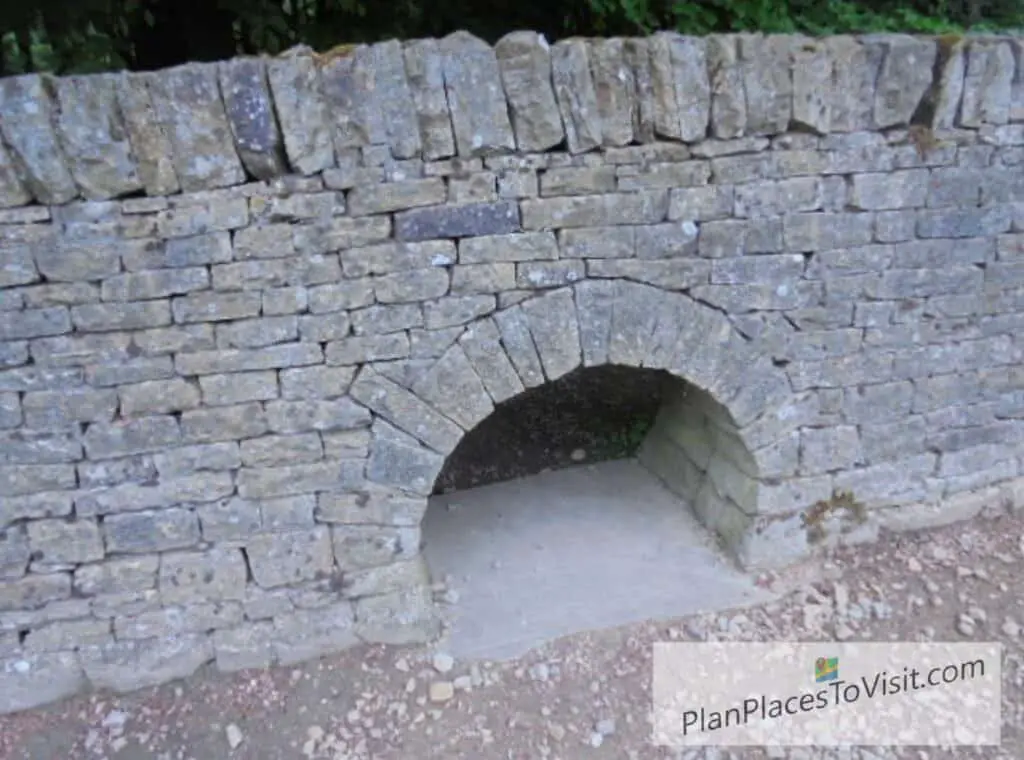
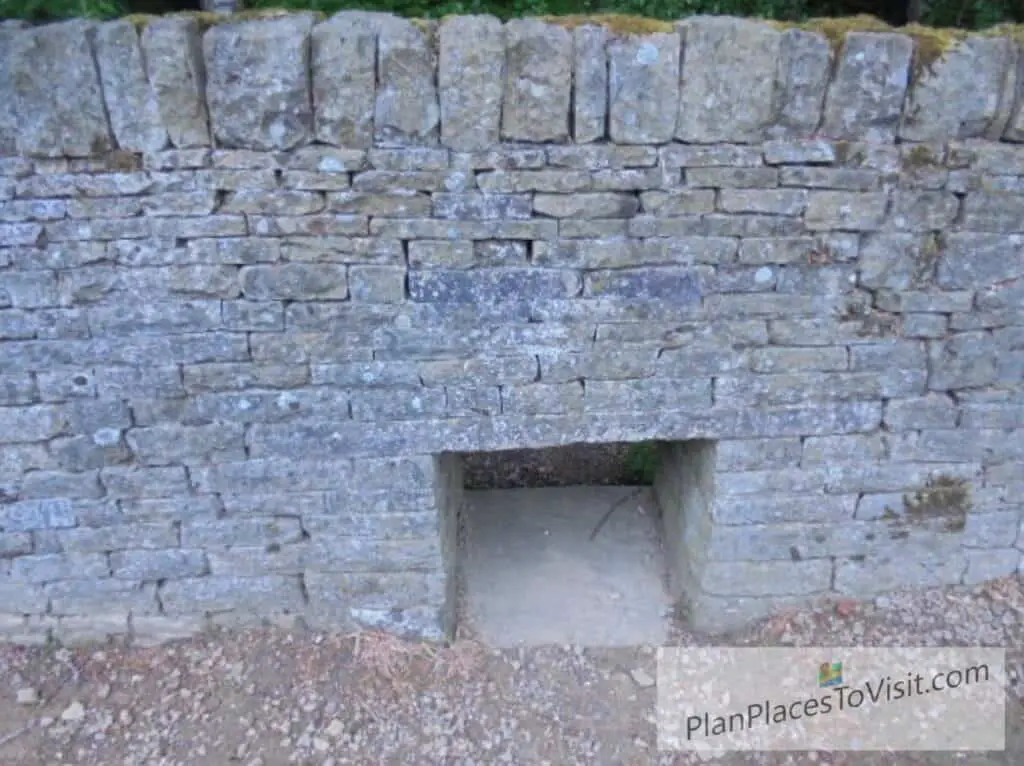
Sloping Ground Dry Stone Walling – dry stone walling method
Generally, when a slope is greater than 20 degrees, a different building technique is adopted to ensure lasting stability of the dry stone wall. The large footings or foundation stones are stepped horizontally into the slope. This follows this horizontal format to the top of the wall. Note the throughs at the centre of the wall run parallel to the base stones. The coursed wall at the lower entrance gives a clear indication of this ‘horizontal technique’.
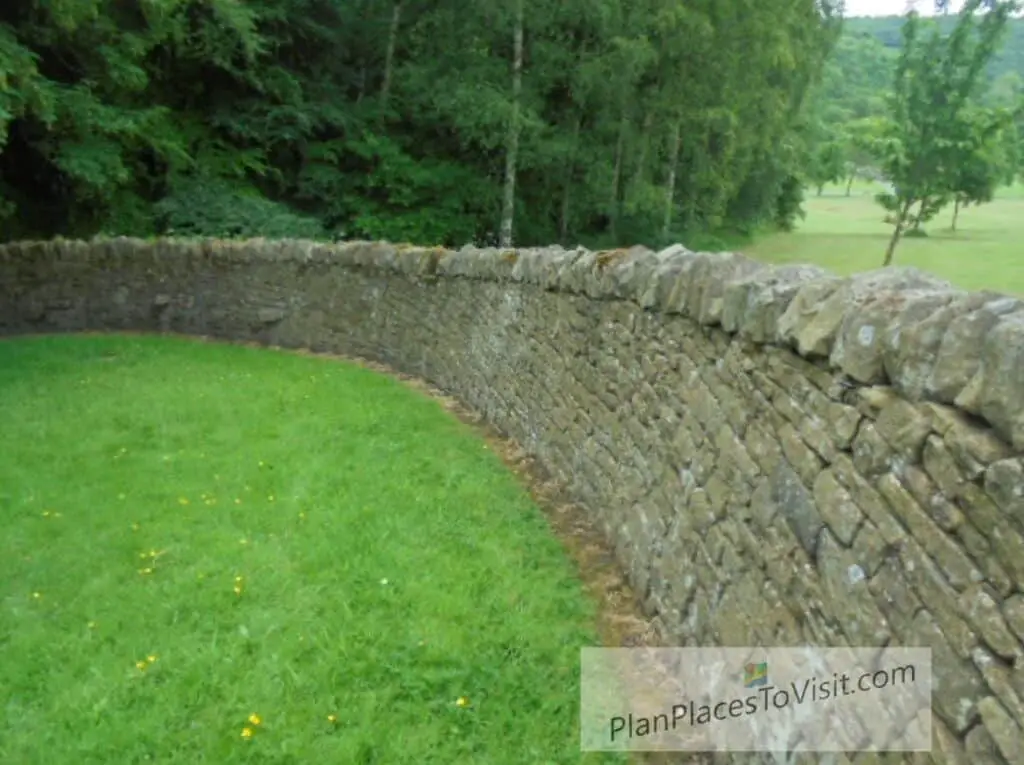
Sloping Ground Drystone Wall at Shibden Park’s Dry Stone Walls in Yorkshire exhibition
Dry Stone Walls in Yorkshire – Sheep Fold
Sheep Folds were constructed to enable shepherds to gather their flocks and practice husbandry at different times of the year. They were not necessarily circular and were often designed in a makeshift fashion to enclose an existing walled corner of a field.
This Sheep Fold is usual in that its design cuts into rather than follow the contours of the land to ensure a horizontal base. The lower part of the wall is therefore quite tall and the upper shorter section has a retaining function. The uncut extended throughs near the entrance provide rough seats. The two monoliths support the wall at its entrance giving the fold a kind of Celtic spiritual enclosure.
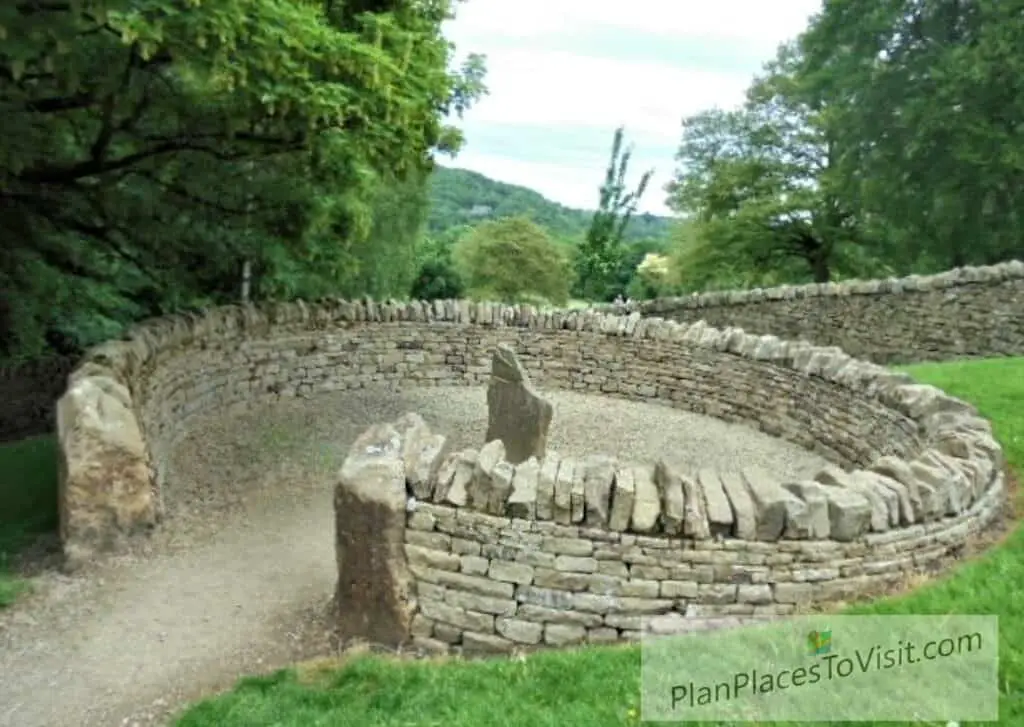
Dry Stone Walls in Yorkshire – Circular Sheep Fold Exhibit at Shibden Park
Dry Stone Walls in Yorkshire – Stiles
There are many types of stiles in the dry stone walls – with several ways of safely passing through or over a dry stone wall and these four stiles are the most common.
Squeeze Stile
A Squeeze Stile is so designed to allow easy access but not that of mature cattle. Note the Cheekend method of construction and the heavily dressed copestones which secure the top of the wall on either side of the squeeze.
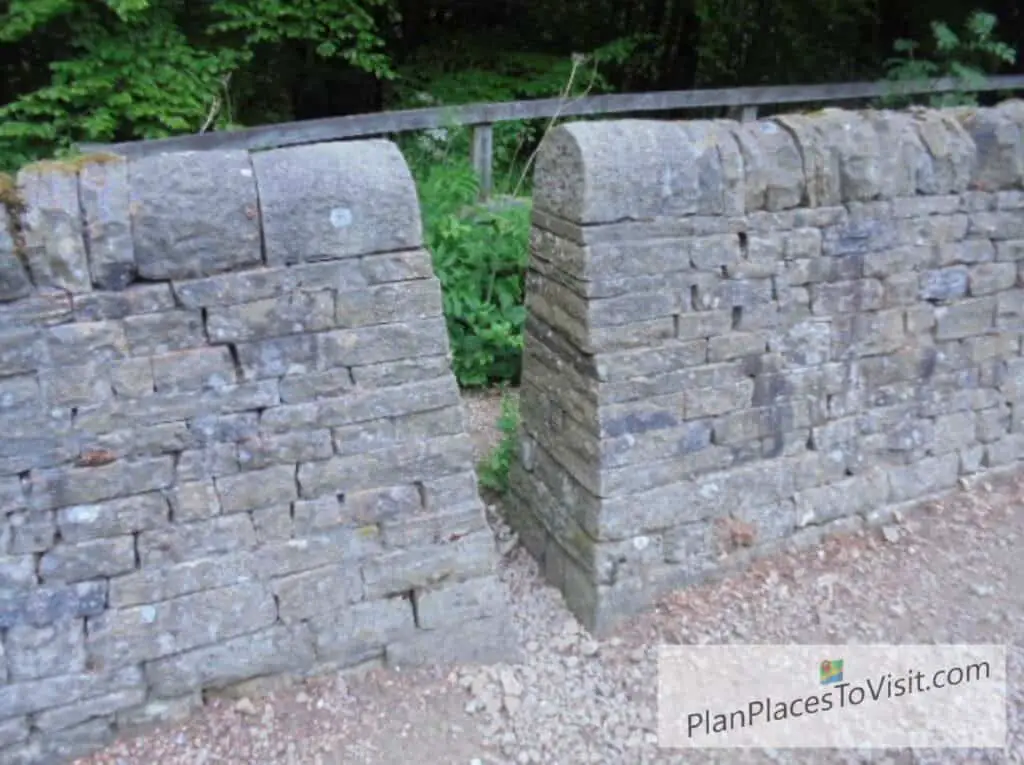
Squeeze Stile
Stump Stile
Stump stiles have similar characteristics to a squeeze stile in both design and construction but it has a stop stone erected on each side to limit passage through.
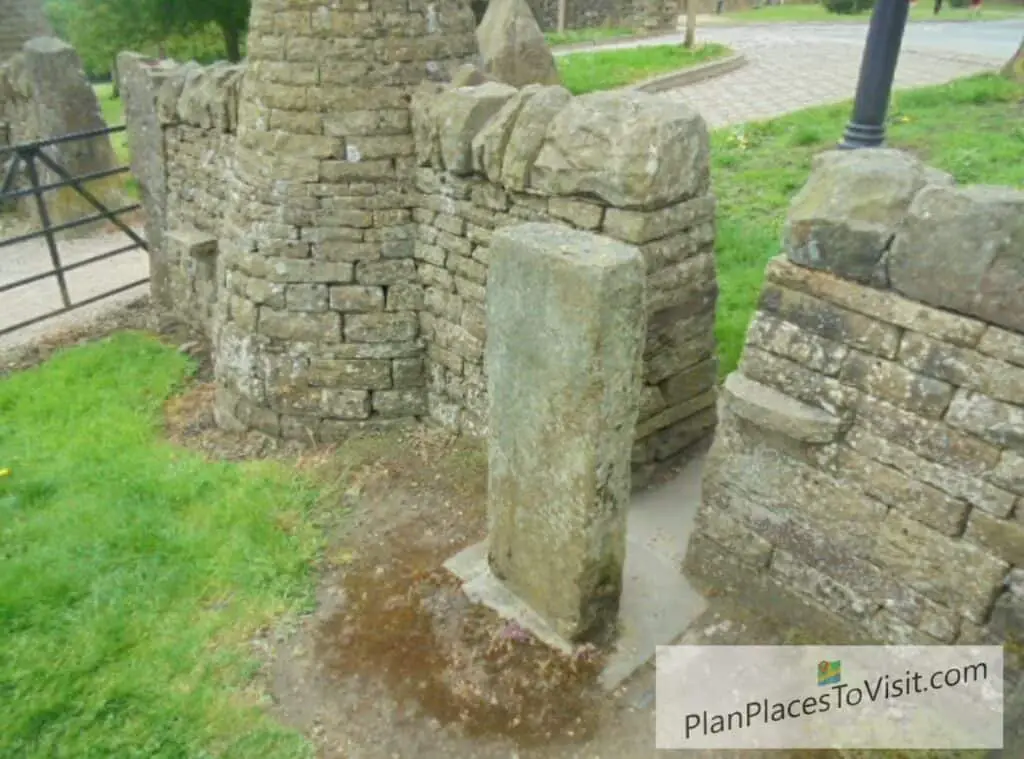
Stump Stile
Step Through Stile
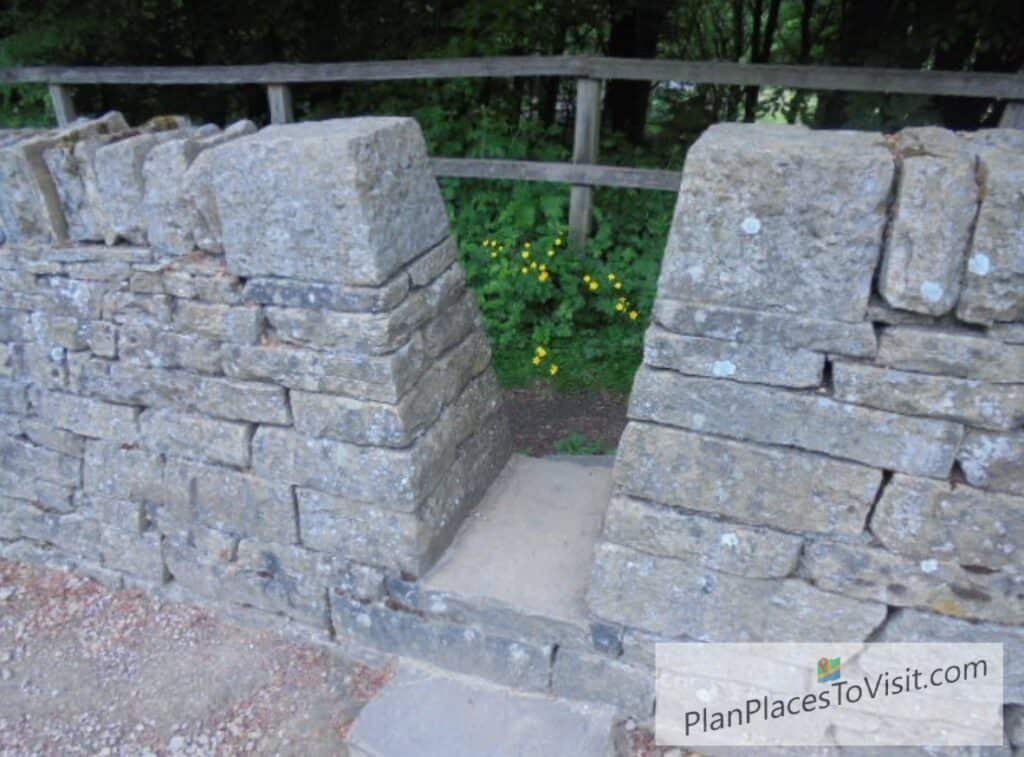
Step Through Stile
Step Over Stile
A Step Over Stile is made up of three or more long through stones which are built into the dry stone wall and form a natural staircase over the wall.
The large dressed stone in the photograph which secures the top line of copestones is an example of a Hogback copestone.
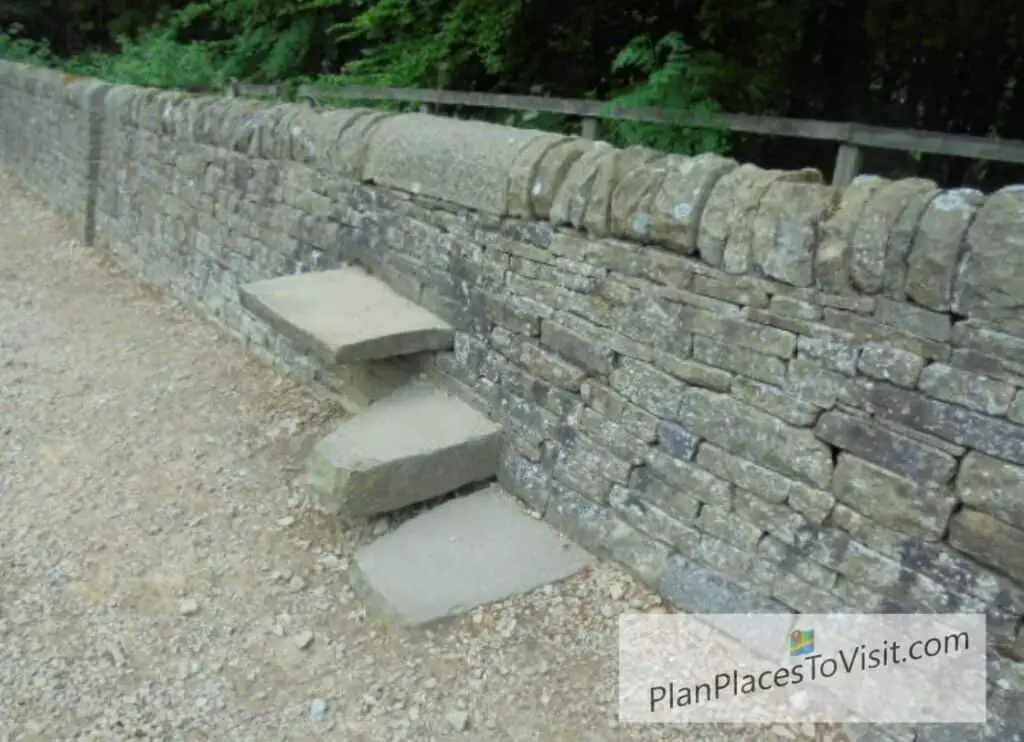
Cheekend or Wall Head – dry stone walling method
These are the most common terms used to describe the end of a dry stone wall that has been finished vertically and butts up to a gate post or building or simply marks a decorative entrance to a track, drive or fold.
It is important where possible that long stones on alternate courses are laid across and into the length of the wall. Holding all this together is a long, heavy copestone called a hogback which in this case has been shaped from a rectangular block of sandstone using a pitching tool and punch.
Both the Hogsback and the wall construction ensure that the Cheekend is sealed, remains secure and does not peel away from itself. If you look carefully at two sides of the styles and the rectangular Lunky you will see that the same building techniques are used.
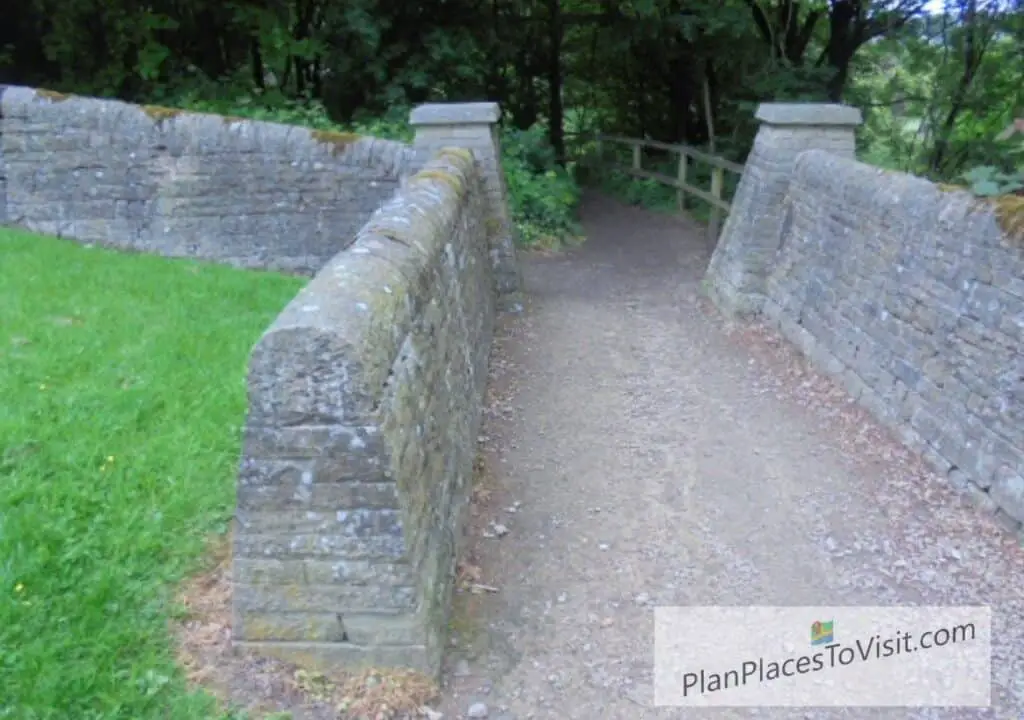
Cheekend or Wall Head
Boulder Wall – dry stone walling method
This type of wall is built from coarse-grained uneven bedded random carboniferous sandstone. This example at Shibden Park in the Dry Stone Walls in Yorkshire exhibit used stone brought from the valley bottom at Slaithwaite, Huddersfield. It was removed by Kirklees Council to make way for a graveyard extension and recycled in a field wall at Mount Tabor, Halifax and then gifted to the Dry Stone Walls in Yorkshire exhibition project.
Note the rugged, weighty flat copestones which ensure the wall is stock proof. The large boulders in the base often determine the line of the wall, built to mark the boundary of a field. The stone was donated by Nigel Goody and Simon Lumb.
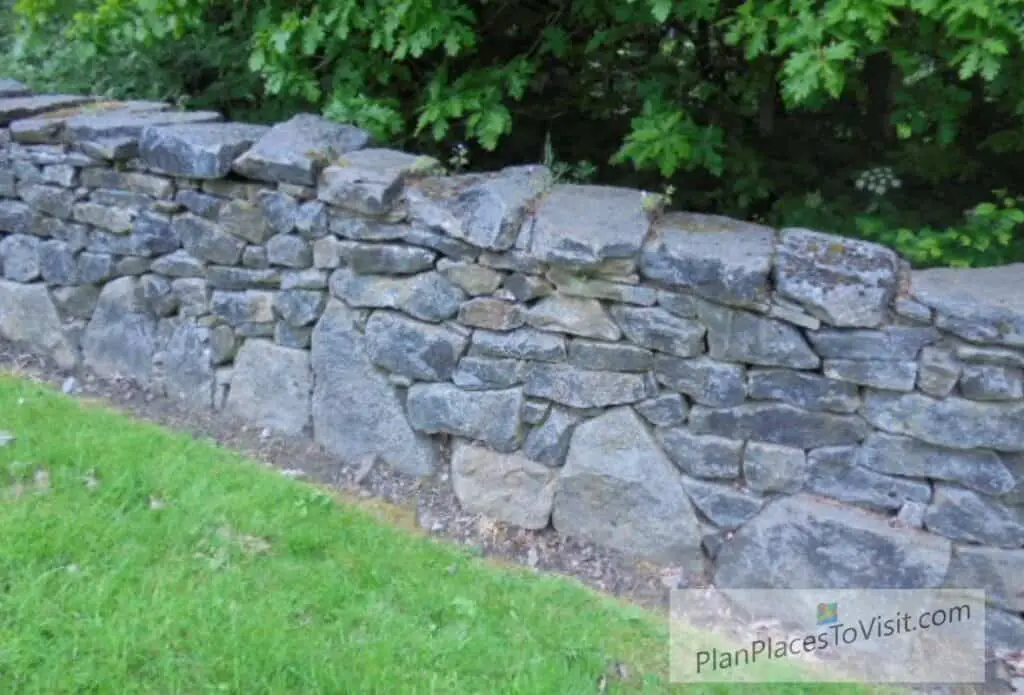
Boulder Wall Dry Stone Wall
Random Limestone – dry stone walling method
Stone from the Mid-Craven fault between Malham and Burnsall, contains marginal deposits with abundant shelly fauna including large brachiopods, various gastropods and occasional bivalves as well as intrusive mineral deposits such as lead.
Such stone is difficult to cut and work and so it is built as it comes to hand in a random style. It is especially important to lay the length of each stone into the wall. The stone is usually small with a general absence of throughs.
The stone for the random limestone drystone wall at Shibden Park Dry Stone Walls in Yorkshire exhibit was donated by Swinden Quarry near Cracoe, Grassington in the Yorkshire Dales National Park.
Swinden Quarry is also known as Rylstone Quarry and once excavations are complete in 2039, it is due to become a 144-metre-deep lake.
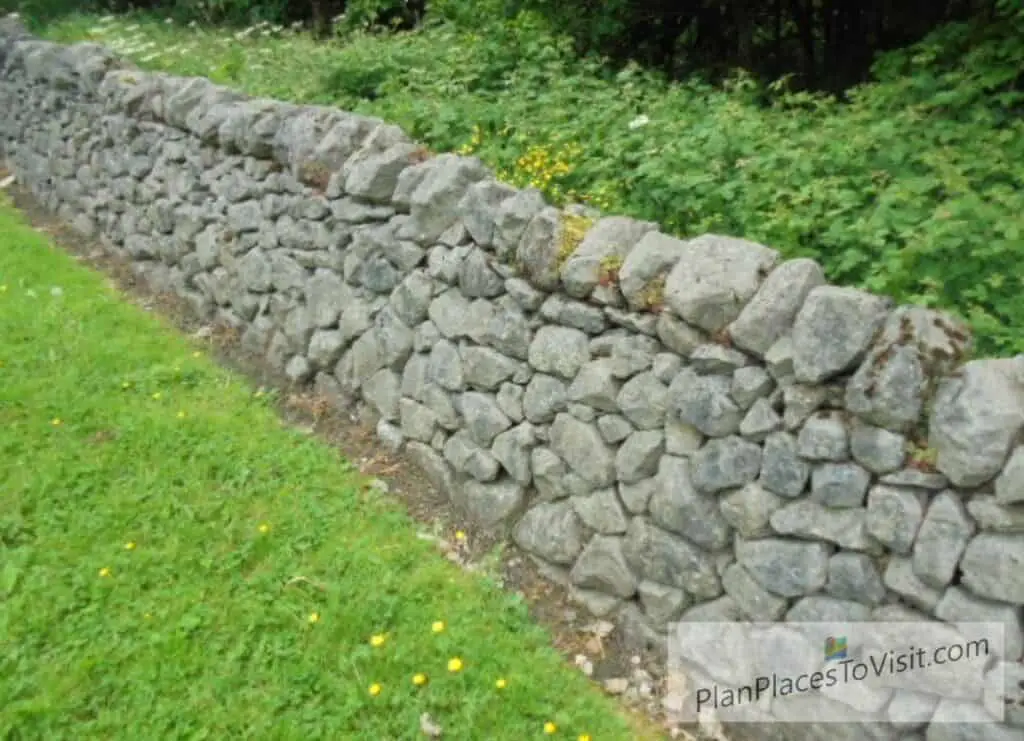
Dry Stone walls in Yorkshire Random Limestone
Random Limestone Black and White – dry stone walling
Horton Quarry in Horton in Ribblesdale began operating in 1888 when an enterprising Irishman saw an opportunity for new lime works when the railway was being built in Ribblesdale (the Settle to Carlise line with the Ribblehead viaduct).
A huge extension to the quarry was granted in 1940 as pure limestone was needed for a revived steel industry due to war efforts. Quarrying of the Great Scar Limestone takes aggregate from the Gordale, Cove and Kilnsey limestones. These samples from the same quarry were donated by Horton Quarry. The grey limestone shines as black as jet when it is wet.
Leyburn – dry stone walling method
This Wensleydale panel from the Leyburn area is typical of the unique geology which produces layers of sandstone, limestone and shale. Traditionally, these walls have courses of closely fitting, often protruding throughs called ‘trulls’ laid parallel rather than horizontally to the ground. Locals call this ‘wallinth ‘il’ – literally walling with the slope or hill. In tall walls, there may be two or even three such courses.
Corner – dry stone walling method
These walls were built in the same fine bedded sandstone contained in the Shibden Estate wall and conical cairns which mark the lower and upper entrances.
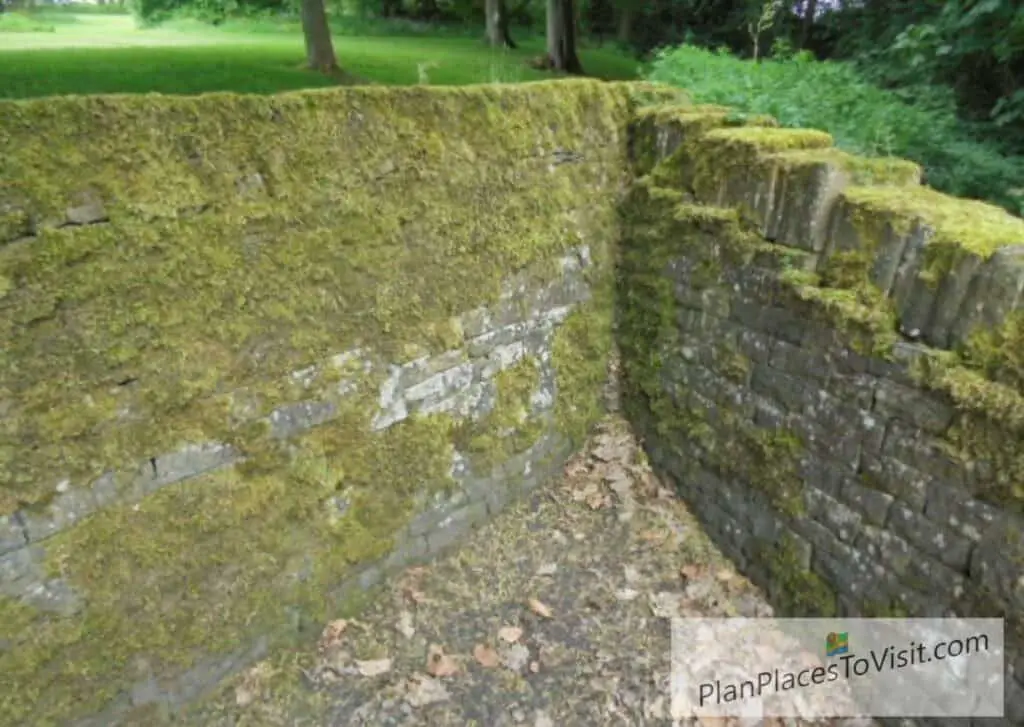
Corner example of Dry Stone Walling at Shibden Park
Random Gritstone -dry stone walling method
The stone in this panel was donated by Len Robinson of High Wood, Riddlesden, Keighly, and originated from a redundant field wall on his land which nestles in the shadow of Rivock Edge overlooking the Airedale and Worth Valleys.
This wall is typical of most of the walls in this area and closing fields and moorland. The Millstone Grit from which the stone derives was laid down during the carboniferous period and not only gives character to local towns but gives the area its acid soils, heather moors, soft water and rocky scars.
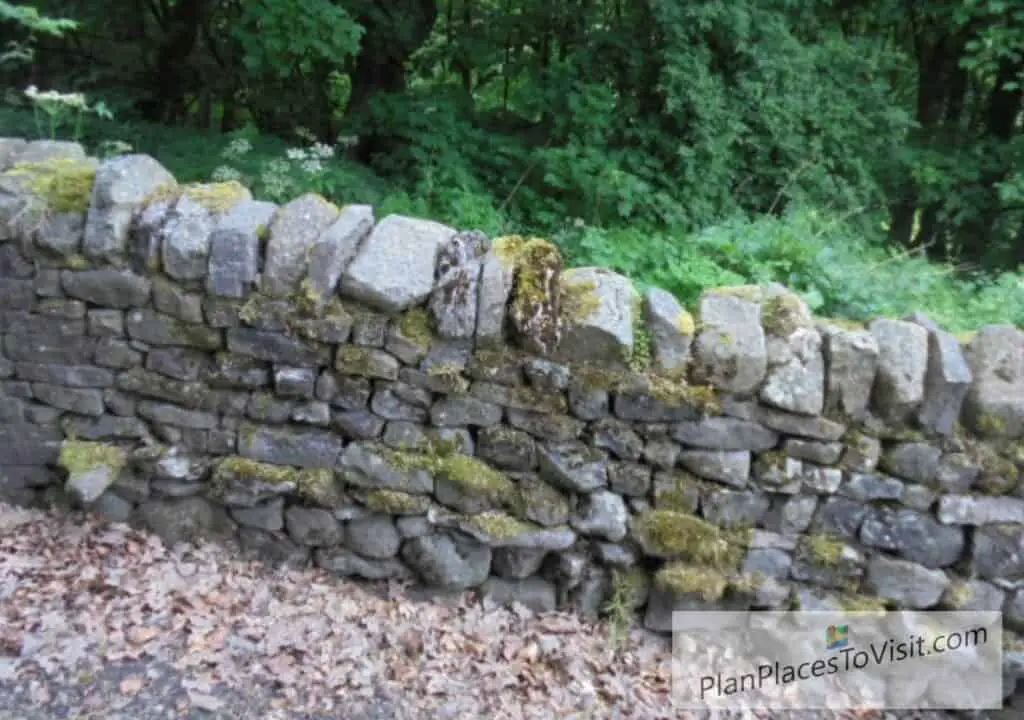
Random Gritstone Dry Stone Walling
Slab Fence – dry stone walling method
This slab fence is a fine example of the rarely seen walls of this type in West Yorkshire. It is made of bedded sandstone and is of similar material used for York Stone slabs used in Yorkshire’s pavements and mill building floors.
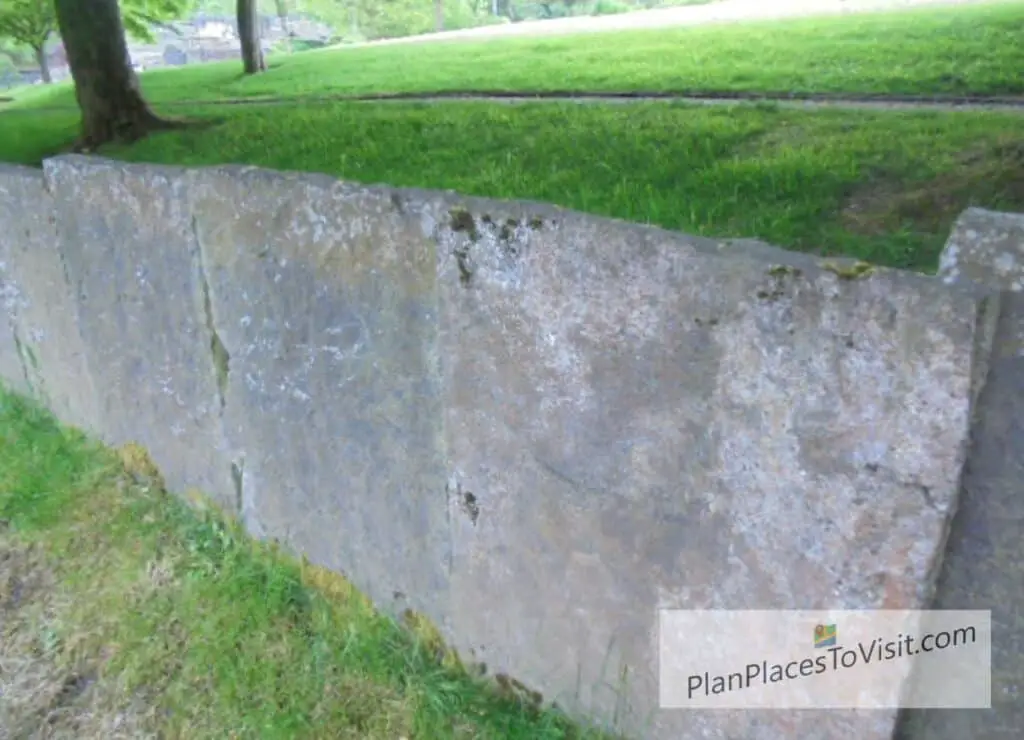
Slab Fence Dry Stone Wall at Shibden Park
Smoots – dry stone walling method
Smoots are the small holes at the foot of the wall designed to allow the passage of small animals and creatures such as hedgehogs through to the other side of the wall. Smoots are also used to provide minor through-wall drainage.
The stone used in the build came from the same Swindon Quarry near Grassington described in the random limestone drystone wall at Shibden Park. The throughs are bedded sandstone.
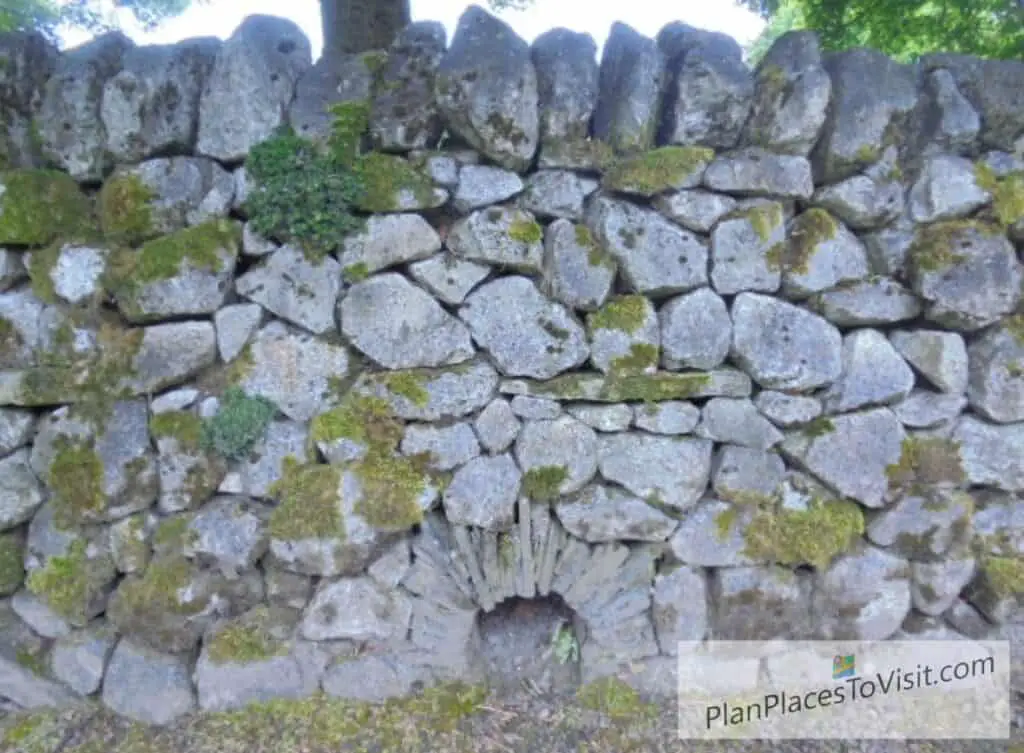
Smoots are Small Holes at the Foot of Dry Stone Walls to Allow the Passage of Small Creatures such as Hedgehogs
Bee Boles – dry stone walling method
A Bee Bole is a cavity or alcove in a wall. The stone used in this Bee Bole at Shibden Park Dry Stone Walls in Yorkshire exhibit is fine-grained carboniferous sandstone (300 to 350 million years old) taken from a redundant field wall 1,000 ft above sea level on the outskirts of Huddersfield. It was originally sourced from a local roofing slate production quarry between 1800 and 1880 and was donated by Lunds Landscape Walling.
The stone bee skep, an upturned basket under which bees form their naturally curvy honeycomb was donated by the Halifax Bee Keepers.
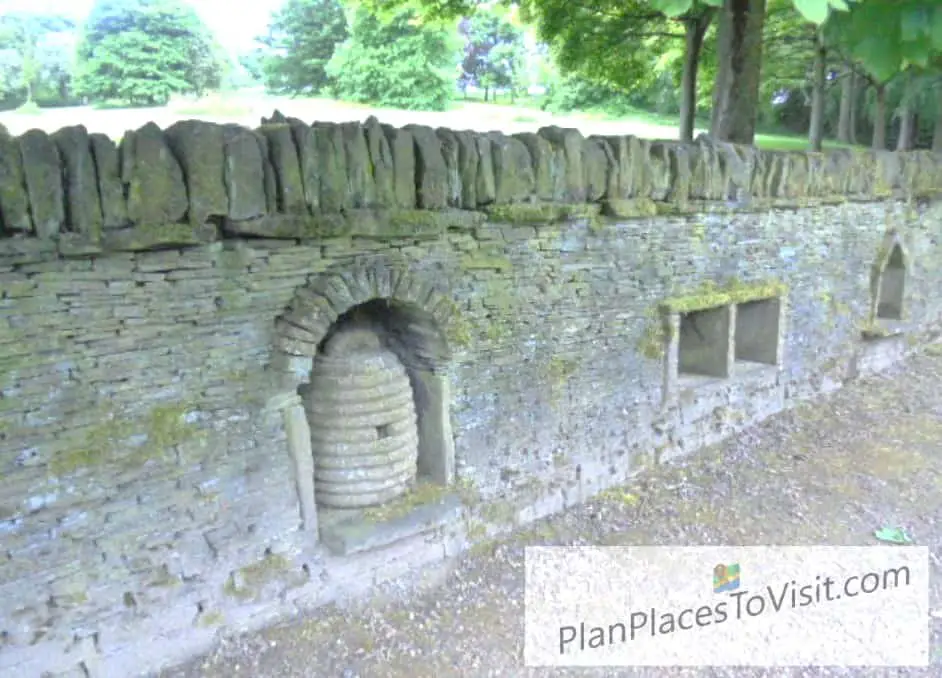
Dry Stone Walls in Yorkshire – Bee Boles at Shibden Park, Halifax, Calderdale
Dry Stone Wall Seats -dry stone walling method
Dry stone wall seats are common throughout West Yorkshire and this traditional sandstone field walling is often blackened by historic industrial pollution.
Field wall stone is revealed in the early stages of quarrying for sedimentary sandstone and is found in the ‘overburden’ layer below vegetation, topsoil, subsoil, and above sandstone and freestone.
This dry stone wall at Shibden Park is made from rough field wall stone donated by Johnson’s Wellfield Quarry and uses extra-long through stones to protrude and create a sequence of simple seats.
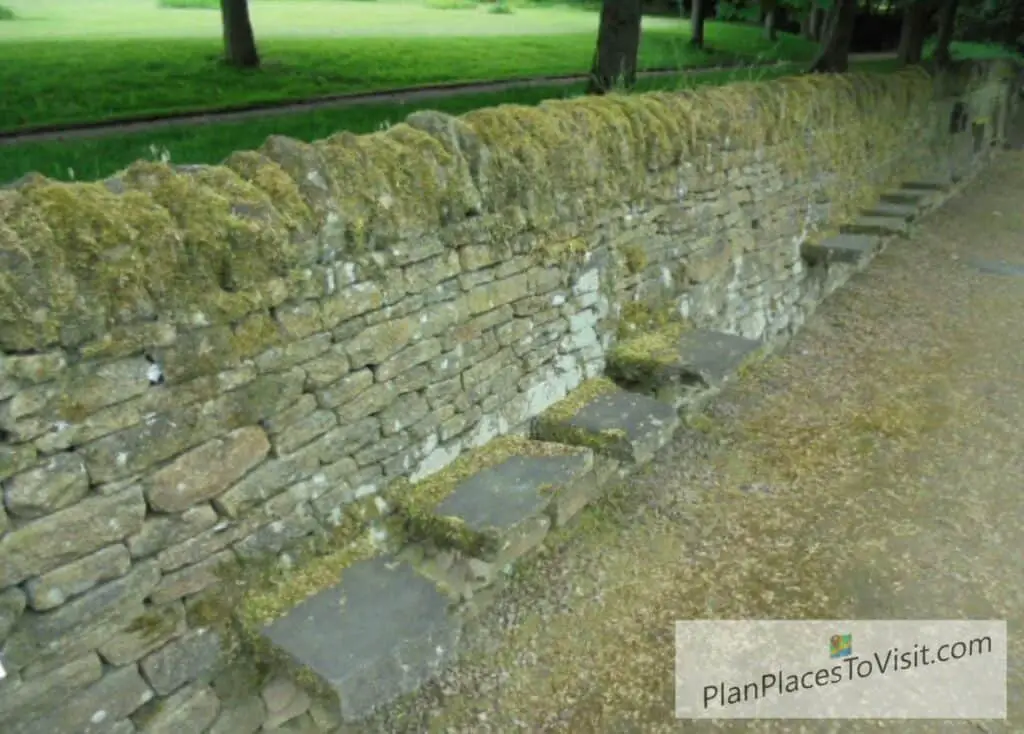
Dry Stone Wall Seats
Yoredale Series Limestone Dry Stone Walls
Laid down 350 million years ago Great Scar limestone is typical of the outcrops found at Malham Cove, Gordale Scar and Kilnsey Crag in the Yorkshire Dales National Park. The stone in this dry stone wall panel, known as Yoredale Series Limestone lies above the Great Scar limestone. It is typical of that found high on the upper reaches of Wharfedale above the village of Hubberholme and is characterised by a thin brittle structure.
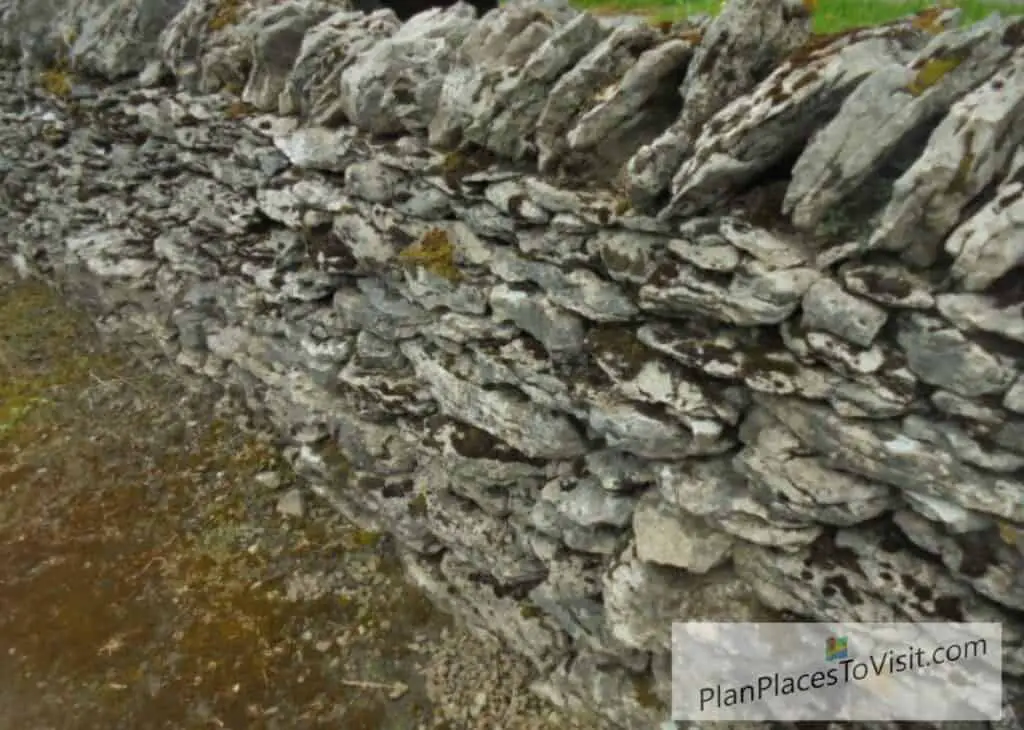
Dry Stone Walls in Yorkshire- Yoredale Series Limestone
Dry Stone Shepherd’s Hut with a Corbelled Roof
The dry stone shepherd’s hut was built to provide rough shelter in the upland Yorkshire landscape for a shepherd to live temporarily amongst the flock, especially during lambing.
There are not many examples still standing in Yorkshire but one or two can be found across the side of the Three Peaks area around Ingleton.
The outstanding dry stone feature of the shepherd’s hut is the corbelling technique used to build a circular roof in dry stone without supporting timbers.
The stone used in the construction of the shepherd’s hut at Shibden was kindly donated by Johnson’s Wellfield Quarry in Huddersfield. There were approximately 30 tons of stone used in this construction.
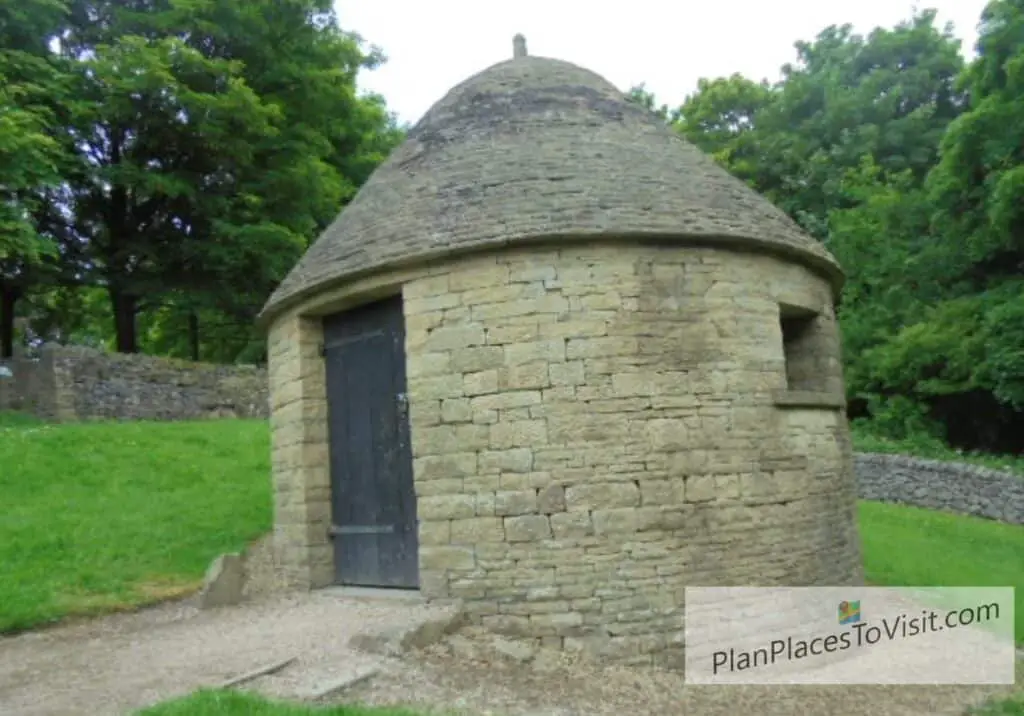
Retaining and Training Walls
This is a training area at Shibden Park Dry Stone Walls in Yorkshire exhibition where the basic drystone walling techniques are taught on a regular basis. The Yorkshire Dry Stone Walling Guild run courses at various locations including Fountains Abbey, Castle Bolton and Bingley.
The dry stone training wall at Shibden is built with bedded sandstone and random limestone and a large retaining wall is constructed with pieces of every type of stone left over from the construction of the whole project. Note the lines of sandstone used to tie the limestone build together.
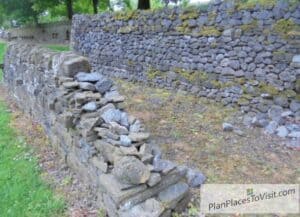
Where is Anne Lister’s Monument and the Dry Stone Wall in Yorkshire Exhibition?
It is located within the grounds of Anne Lister’s (Gentleman Jack) home in Halifax, Calderdale, West Yorkshire at Shibden Park near the Upper Car Park at Shibden Hall. Please refer to our map below for directions.
Other things to do on your visit to Shibden Park and Shibden Hall
At Shibden Park there is a children’s adventure play area, cafe, boating lake, miniature railway, land train, children’s rides, ducks to feed, and huge gardens so all ages can explore or enjoy picnics and a folk museum with an aisled barn. Of course, there’s also the facinating history of the hall itself to see dating back to 1420 with Shibden Hall, Gentleman Jack – Anne Lister and Ann Walker.
Whilst in the area, the centre of Halifax is 1.5 miles away with the magnificent 1779 Piece Hall at its heart as well as Halifax’s award-winning pubs and bars.

